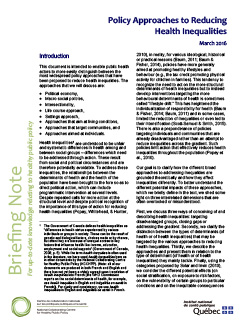Policy Approaches to Reducing Health Inequalities
This document is intended to enable public health actors to more easily distinguish between the most widespread policy approaches that have been proposed to reduce health inequalities. The approaches that we will discuss are:
- Political economy,
- Macro social policies,
- Intersectionality,
- Life course approach,
- Settings approach,
- Approaches that aim at living conditions,
- Approaches that target communities, and
- Approaches aimed at individuals.
Health inequalities1 are understood to be unfair and systematic differences in health among and between social groups – differences which need to be addressed through action. These result from social and political circumstances and are therefore potentially avoidable.
With this document, we have set out to shed some light on the ways that various broad policy approaches attempt to account for and address health inequalities. While it is widely understood within public health generally (and particularly among those who work in the areas of the social determinants of health and health inequalities) that addressing inequalities is best done at the level of the social determinants of health inequalities, the majority of attempts to address these have been and continue to be focused on downstream determinants and particularly on individual behavioural determinants. This has meant that health inequalities between social groups, although they have been the focus of much work for well over twenty years, have not been substantially reduced, and in many cases, have in fact increased (Scott-Samuel & Smith, 2015). By concentrating on where they are situated along the continuum of social determinants of health inequalities - social determinants of health, we can see where the policy approaches are likely to intervene and what we might expect their effects to be.
- The Government of Canada defines health inequalities as “differences in health status experienced by various individuals or groups in society. These can be the result of genetic and biological factors, choices made or by chance, but often they are because of unequal access to key factors that influence health like income, education, employment and social supports” (Government of Canada, 2008, p. 5.


